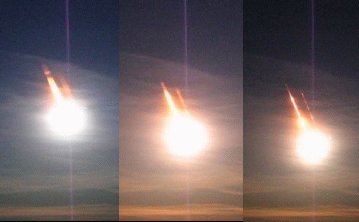Fireball would rank among the year’s sky highlights, expert says
updated 6:01 p.m. PT, Fri., Nov. 21, 2008
CALGARY,
Alberta - A massive ball of fire that lit up the skies over two Western
Canadian provinces on Thursday evening was likely among the biggest
meteor events to be witnessed in Canada this year, one expert said.The
fireball, which streaked through the darkening skies over Alberta and
Saskatchewan at about 5:30 p.m. Calgary time, likely weighed between 1
and 10 tons and shone brightly enough to be seen over an area 435 miles
(700 kilometers) wide."It
was somewhere between the size of a chair to the size of a desk," said
Alan Hildebrand, a planetary scientist at the University of Calgary and
a coordinator of a fireball reporting service.
https://www.msnbc.msn.com/id/27848645/ SEE VIDEO
Bright Meteor Seen Over Western Canada

Images of the meteor. Credit: SpaceWeather.com A bright fireball lit up the sky over parts of Canada and was probably
a meteor which may have hit the ground in central Alberta. Reports from
all over western Canada said the bright flashes occurred at 5:30 pm MST
on Nov. 20. The bolide split the evening sky and fragmented during a
series of booming explosions. The image above is from a video taken by
Andy Bartlett, who recorded the event from a 10th-floor apartment in
Edmonton, Alberta with his Canon A510. Watch the movie here. "The
brilliant fireball appeared to be closer than the airplane in the upper
right corner of this video," said Bartlett. Another video was taken by
a serendipitously placed surveillance camera. See a news report from a Canadian television station here.
~~~~~~~~~~~~~~~~~~~~~~~~~~~~~~~~~~~~~~~~~~~~

Strange shapes and textures can be found in neighborhood
of the Cone Nebula.
The unusual shapes originate from fine interstellar
dust reacting in
complex ways with the energetic light and
hot gas being expelled by the young stars.
The brightest star on the right of the
above picture is S Mon,
while the region just above it has been nicknamed the
Fox Fur Nebula for its color and structure.
The blue glow directly surrounding S Mon results from
reflection,
where neighboring dust reflects light from the bright star.
The orange glow that encompasses the whole region results not only from
dust reflection but also emission from
hydrogen gas ionized by starlight.
S Mon is part of a young
open cluster of stars named
NGC 2264, located about 2500 light years away toward the constellation of
Monoceros.
The origin of the mysterious geometric Cone Nebula, visible on the far left, remains a mystery.
https://antwrp.gsfc.nasa.gov/apod/astropix.html
~~~~~~~~~~~~~~~~~~~~~~~~~~~~~~~~~~~~~~~~~~~~~

CORONAL HOLE: Japan's Hinode spacecraft is monitoring a dark hole on the sun--a
coronal holeCoronal holes are places in the sun's atmosphere where
the magnetic field opens up and allows solar wind to escape. In
images taken by X-ray telescopes, such as the one Hinode uses, coronal
holes appear dark because the hot glowing gas which would otherwise
fill them has spilled out in the solar wind. A stream of gas flowing
from this particular hole is heading for Earth. High-latitude sky
watchers should be alert for auroras when it arrives on Nov. 25th or 26th.:
~~~~~~~~~~~~~~~~~~~~~~~~~~~~~~~~~~~~~~~~~~~~~
Dark Matter Proof Found Over Antarctica?
Anne Minard
for National Geographic News
for National Geographic News
November 19, 2008
High-energy electrons captured over Antarctica could reveal the presence of a nearby but mysterious astrophysical
object that's bombarding Earth with cosmic rays, researchers say.Or the electrons may be the long-awaited physical evidence of elusive dark matter.
continues https://news.nationalgeographic.com/news/bigphotos/44410460.html
~~~~~~~~~~~~~~~~~~~~~~~~~~~~~~~~~~~~~~~~~~~~
- On the Saturnian moon
Enceladus, jets of powdery snow and water vapor, laden with organic
compounds, vent from the “tiger stripes,” warm gashes in the surface.
How can a body just over 500 kilometers across sustain such vigorous
activity? - The answer may be the presence of underground
fluids, perhaps a sea, which would increase the efficiency of heating
by tidal effects. Support for this idea has come from recent flybys. - If
Enceladus has liquid water, it joins Mars and Jupiter’s moon Europa as
one of the prime places in the solar system to look for
extraterrestrial life.
When the Voyager 2 spacecraft sped through the Saturnian system more than a quarter of a century ago,
it came within 90,000 kilometers of the moon Enceladus. Over the course
of a few hours, its cameras returned a handful of images that
confounded planetary scientists for years. Even by the diverse
standards of Saturn’s satellites, Enceladus was an outlier. Its icy
surface was as white and bright as fresh snow, and whereas the other
airless moons were heavily pocked with craters, Enceladus was mantled
in places with extensive plains of smooth, uncratered terrain, a clear
sign of past internally driven geologic activity. At just over 500
kilometers across, Enceladus seemed far too small to generate much heat
on its own. Yet something unusual had clearly happened to this body to
erase vast tracts of its cratering record so completely.
https://www.sciam.com/article.cfm?id=enceladus-secrets continues
~~~~~~~~~~~~~~~~~~~~~~~~~~~~~~~~~~~~~~~~~~~




